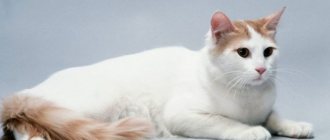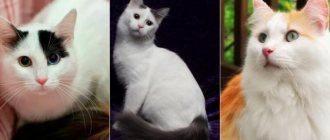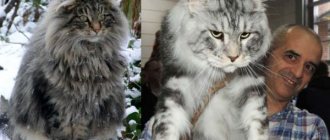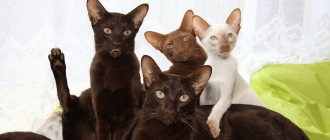History of the Siberian breed
Written references to animals similar to the modern Siberian cat breed appeared in the 16th century. Then they were called the Bukhara breed. For residents of the Volga region, this name is still relevant.
Subsequent mentions are known from the 18th century. We were talking about large furry pets brought by merchants through the Silk Road. Cats were brought to Siberia to fight mice. The Siberian breed has not survived in its pure form: they naturally crossed with forest and steppe cats. From them the breed inherited endurance and strength.
Description and standard
The Russian Siberian cat has a spectacular appearance. From her ancient ancestors she borrowed a muscular body and fluffy fur. Most of the features were formed due to the harsh climate of the northern region.
It was noted that the Siberian breed is more suitable for allergy sufferers than others. The pattern of why these cats produce fewer antigens has not yet been proven by science. After all, it is antigens that are responsible for the occurrence of an allergic reaction, and not wool, as many believe.
Some people confuse Siberian and Persian cat breeds. Therefore, there are standards that determine whether an animal belongs to a certain breed.
The Siberian cat has the following breed description:
- representatives have a large and muscular build;
- neck relatively short;
- the rounded muzzle has a prominent chin, a wide nose, low-set cheekbones and a forward forehead;
- large eyes are set wide apart and have a slightly oval shape;
- the ears are set wide apart and may have small tufts at the tips;
- the fluffy tail has undercoat.
A unique feature of Siberians is their waterproof coat. Thick guard hair in combination with a long, developed undercoat forms a dense coat.
Since Siberians are quite heavy, the weight of a Siberian cat can reach 5-6 kg, and cats of this breed can weigh up to 10 kg. At the same time, growth at the withers is up to 33 cm in cats and up to 40 cm in males.
How long does a Siberian cat live? The average life expectancy of Siberians is 15-20 years.
Black spotted color of Siberian cats
According to the color system adopted by FIFE and WCF, the harlequin color is designated SIB n 24. Other names for this color are brown spotted, black spotted.
The black spotted coat is often confused with the black brindle. With black spotted cats, there should be clear spots on their sides.
There is a variety of spotted color - “torn marble”. This is a very impressive color. This color is characterized by large spots on the sides.
In some cases, these spots have the appearance of “rosettes”, the middle of which is lighter. This color is similar to the color of breeds that were bred based on the use of wild animals (for example, Bengal cats).
Colors of Siberians
The Siberian cat's color is endowed with variety and a palette of shades. Breeders have developed such colors as smoky, tabby (the presence of patterns and spots) and tortoiseshell (a combination of shades of red and black in one color). The most common are two-color and three-color cats, but the rarest and most expensive are the plain Siberian cats without any pattern.
The colorpoint Siberian cat is often called the Neva masquerade cat. This interesting color was the result of the love between Siberians and Siamese cats.
The Siberian white cat resembles the Angora beauty. The uniform color excludes the presence of any patterns or spots on the coat. It is acceptable for kittens to have spots that disappear with age. The eyes of a white Siberian can be copper, golden or blue.
The black Siberian cat has a peculiarity. Kittens at birth have a gray or brown coat. After the first molt, the color becomes deep black and uniform. However, if exposed to the sun for a long time, the black color can fade and acquire a reddish tint.
The Siberian blue cat has fur with the same shade. The nose and paw pads of this color have a gray tint. Protect your pet from direct sunlight and high humidity - this can have a detrimental effect on the color of the fur coat and a reddish tint will appear.
The red-colored Siberian cat is not susceptible to fading in the sun. The coat can have a palette of shades from red to red. It is noteworthy that the nose and paws have a corresponding color.
The Siberian silver (golden) cat got its color due to incomplete pigmentation of the hairs. The smoky color is obtained when the hair on the roots is white and black on the tips. Chinchilla color is obtained when the hairs are dyed by a third or only the tips. Accordingly, the silver Siberian’s fur is colored gray, while the golden Siberian’s is apricot-colored.
Smoky color of Siberian cats
This color is obtained by mixing recessive without agouti and silver colors. The result obtained depends on the original color of the parents.
You may get:
- " black smoke",
- "blue smoke"
- "red smoke"
- smoky tortoiseshell cat.
Ideally, the features of this color are noticeable only when the cat moves - this is a bright white undercoat. Moreover, it is better if the contrast between the color of the main coat and the undercoat is as bright as possible.
With a smoky color, a contrast is visible between the light silver undercoat and the main coat color, which partially covers the ends of the hair and concentrates on the ears, paws, and tail. The outer hair at the base has a narrow silvery-white stripe.
The disadvantage is the uneven color on different parts of the body, as well as the presence of a residual pattern.
Character and habits
The character of the Siberian cat was formed in the conditions of its residence and purpose. Hence the pronounced hunting instinct and habits, which in some way resemble those of a dog.
The Siberian cat breed is distinguished by its loyalty. Of all the inhabitants of the house, the pet chooses one owner. Siberians are not afraid of the presence of foreign animals, but they will inform their owners about their appearance.
The character of the Siberian cat is playful and reasonable. In terms of toys, pets are not whimsical and play with all available objects, and can also bring some in their teeth. But before you climb somewhere, be sure to make sure that this idea is safe.
This breed is not indifferent to heights. An alternative to being on a cabinet can be a vertical structure where the pet can rest.
Siberians are characterized by restraint in their behavior towards people. However, this does not reduce their love for affection and respect.
Care and maintenance
Caring for a Siberian cat will not cause problems. The coat should be brushed daily only during the shedding period. The rest of the time, a couple of times a month will be enough. Metal combs with small teeth work best. When shedding, use a slicker brush.
Remember that these are strong-willed animals! No matter how unusual it may sound, the Siberian breed needs walks outside. In cold weather, 10 minutes is enough. If you have a private home, this will make the toilet issue easier - Siberians are easy to train.
When walking in summer, avoid spending long periods of time in the sun. This is fraught with the fact that the wool may fade and the color will become duller.
When the ears get dirty, you need to clean them. Take care of the condition of your teeth: it is easier to prevent the appearance of stones than to treat them. As for the claws, you don’t have to trim them; it’s enough to accustom your pet to the scratching post.
The pet will be happy if it has a separate place for games and relaxation.
The basic nutrition of the Siberian cat is the same as that of all felines. Siberians are genetically predisposed to a variety of natural foods. The only point: up to 3 years old, a Siberian kitten needs a large amount of protein (70% of the bulk). This is due to the formation of the animal’s muscles.
White color and combinations with it
This option is incredibly effective.
White
The cat's fur does not have any spots or admixtures of other colors. This, by the way, often misleads some people. The pure white cat of this breed, without the slightest hint of the presence of other colors, can be mistaken for a breed called Turkish Angora.
Sometimes there are animals with sky-blue eyes. This spectacle is incredibly beautiful, but, alas, it is a sure recessive sign of hereditary deafness in an animal. But heterochromia - different colors of the iris - does not entail hearing problems, so cats with different eyes are absolutely healthy.
The tip of the nose and paw pads of snow-white “Siberians” are soft pink, the coat is long and thick, requiring regular combing, although its structure is more rigid and is not prone to tangles.
Bicolor
Bicolor is a combination of two colors in the color of an animal. The main color can be tortoiseshell or plain. White occupies from a third to half the surface of the cat's fur coat, with clear color boundaries. Very interesting patterns can be found in this combination. For example, a white tip of the tail with white socks on the paws, as well as a white bottom and black top.
Health and breed diseases
The Siberian cat does not have any diseases of the breed as such. Animals have good health and stamina. The only weak point is digestion and, as a result, a predisposition to obesity. Follow the rules of nutrition and you will be healthy.
Siberian kittens at 3 months of life are susceptible to developing stomatitis. During this period, teeth begin to change and gums are susceptible to irritation.
Due to the fact that the pet spends time outside (even partially), it is necessary to carry out timely deworming and vaccination according to age.
If the owners know how to care for a Siberian cat, then the pet can live with you for up to 20 years.
How much does it cost and how to choose a kitten
The Siberian breed is in demand not only at home, but also in neighboring countries. Finding a specialized breeder or nursery is not difficult in any big city.
The optimal age for moving to a new family would be 3 months or more. Siberian kittens are easy to distinguish: they are large in size with a large fluffy tail, and have a fluffy collar and “pants.” When choosing, pay attention to the activity and playfulness of the kitten. Excessive calmness and lethargy can signal problems with the health of the animal.
If you want to be sure that your future pet is purebred, ask to see the parents’ documents. As a rule, they record the characteristics of parents up to the 4th generation.
As for prices, their range is quite wide. You can buy a kitten at a bird market or a site like Avito for $50-100. The question is how thoroughbred will he be? After all, a breed is not only a beautiful photo of a Siberian cat - first of all, it is character and habits. If you are applying for a purebred pet, then the price starts from $150-200 and above, depending on the purpose of purchase and color.
Keep in mind that if you plan to breed, a kitten cannot be cheap. He must meet all breed standards and have a pedigree, which is worth the extra money. Kittens that apply to participate in exhibitions, as a rule, have titled parents. Titles add not only prestige to a pet, but also price.
Distinctive features of the breed
The breed characteristics of this cat are surprising. They have a muscular body structure, a wide chest, a large head, and their limbs look powerful due to their fur and bone structure. The elastic belly area and strong neck give it an advantage over other breeds.
The back seems a little higher because... the shoulder corset is slightly lowered down. The shape of the ears is acute-angled with tassels on the tops. They have a slight slope. Long, beautiful and fluffy, as if with a fringe, the tail is slightly lowered down, but does not touch the ground. The eye shape is round.
Watch the TV show “Zoo Academy”, where the authors and guests will tell you about their Siberian pets. The guests, who are also the owners, have a very interesting Siberian color!
It is generally accepted that their eye color is yellow. But depending on DNA and ancestry, the color may vary. The muzzle has massive cheekbones, a wide forehead, and is slightly elongated. A wool collar may be present on the neck. The cat's entire body is covered with long hair with undercoat to prevent the ingress of water and dirt.
The weight of these males of this breed reaches 10 kilograms! Girls weigh half as much. They are considered one of the large breeds. Only the Norwegian Maine Coon can compete with them.
photo: Norwegian Maine Coon.
The color of Siberian cats contains black, gray, red, and white. Additional colors that may be present: blue, beige. Some female species have a tortoiseshell coat color. There are uniform colors, bicolor, patterned (tabby, or tabby). In our gallery we have posted a collection of photographs with Siberian cats of various colors.
As for kittens, their development continues for a long time. It takes five years for this breed to reach medium size. Siberian kittens will be a good anti-stress and will delight you with their playfulness for a very long time!
One can say about Siberian cats that they have a sense of self-esteem and remain calm in almost any situation. They will survive a change of housing and a complete change of home environment without consequences. When letting a Siberian cat out into the street, do not be surprised if upon arrival he brings a trophy in his mouth.
They are peaceful towards people, as mentioned earlier. This is confirmed by both owners and experts. When small children pull their tail or pull their fur, their four-legged friend will never raise his claw to a defenseless baby. The cat will try to leave or pretend that nothing is happening.
You can piss off a Siberian, but you don’t need to. And it will take quite a lot of time for him to start showing aggression. Then “be healthy!” They will not impose themselves with affection or abundant attention to themselves.
Reviews from Siberian cat owners
We live in our house with two cats: a fold and a Russian Siberian. We can say that these are two opposites. Fold-eared Masya is mine, but Siberian Rex is my husband’s. Mine is mostly at home, but the Siberian is constantly either in the yard with his husband or walking somewhere. Several times he brought mice and showed them. Somehow it just happened that he goes to the toilet outside. When he comes, he is always so affectionate. At the same time, the street is a thunderstorm: the neighbor’s cats don’t come to us - a real protector.
I saw a lot of different breeds, my friends have a lot of purebred cats. I went to the exhibition once and simply fell in love with my Siberian Pushinka. As soon as I approached the cage and took it in my arms, I immediately realized - my breed! Strong-willed, restrained and at the same time playful. I take care of the fur: I bought a furminator, a special shampoo, and sometimes during the shedding period I give it a paste. We have been living in perfect harmony for 3 years now.
We have a Siberian cat for 5 years. We picked up the kitten on the landing and went out. Turned out to be purebred. The cat grew up self-sufficient and very loyal. I don’t know: maybe this is a breed trait or gratitude for the fact that he was looked after from a young age. I won’t say that there are many problems with the coat: I brush it once a week, there are no tangles. The fur is soft and fluffy. By nature he is calm, moderately playful, and treats new people with caution.
Tortoiseshell color of Siberian cats
The tortoiseshell color consists of black and red spots evenly distributed throughout the body; even a few hairs can be considered a spot.
Usually only cats have tortoiseshell coloring, but there are exceptions to the rule when tortoiseshell cats are born.
It is believed that genetically tortoiseshell cats are sterile (that is, they are not capable of producing offspring).
Paw pads, nose mirror:
- For black turtles - black or brown, may be spotted pink.
- For blue turtles - blue or spotted with pink.
The requirements for turtles are exactly the same as for the rest of the group of solid colors:
- uniform coloring,
- brightness and saturation for intense black turtles and soft tones for blue-cream,
- no residual pattern.
It is considered correct when red or cream spots are present on the limbs and ears, as well as the presence of a so-called “tongue of flame” on the head or forehead.











